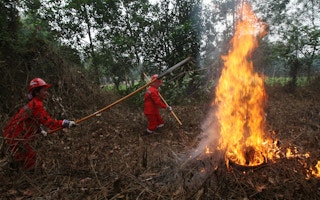Indonesia’s choking annual haze will be limited this year by the pressure of hosting the Asian Games and a new approach to preventing forest fires, a senior official said on Tuesday.
Every dry season—usually from June until October—large parts of Southeast Asia are shrouded in pollution caused by forest fires in Indonesia, many set deliberately to clear land for pulp and paper and palm oil plantations.
Indonesia’s government switched focus from containment to prevention after a particularly bad outbreak in 2015 that cost the country $16 billion and caused more than 500,000 people to come down with respiratory ailments.
“Before 2015 it was all about suppressing the fires, but now it’s about prevention,” said Raffles Panjaitan, director of forest and land fire management at the forestry ministry.
“
If the haze comes, then aeroplanes cannot get through and land, which will stop the athletes.
Raffles Panjaitan, director, forest and land fire management, Ministry of Forestry
The spotlight on Indonesia as it hosts the 2018 Asian Games from Aug. 18 to Sept. 2 makes it all the more important to tackle the problem, he told the Thomson Reuters Foundation.
“If the haze comes, then aeroplanes cannot get through and land, which will stop the athletes,” he said on the sidelines of the Asia-Pacific Rainforest Summit in Yogyakarta, on the Indonesian island of Java.
“It’s important for us,” he said of the Games, which will be co-hosted by the Sumatran city of Palembang and Jakarta.
Over the last three years, Indonesia has introduced a range of new policies including educating and training communities in fire prevention and setting up a Peatland Restoration Agency to tackle fires and protect peatland, said Panjaitan.
Peatlands—made up of partially decayed vegetation, typically saturated with water—hold huge amounts of carbon, and are important habitats for endangered species, like tigers, according to the campaign group Greenpeace.
It has drafted in the military, built early warning towers and organised patrols to monitor the burning, he said.
Panjaitan said better coordination of local governments, villagers and companies could help reduce the risk.
Local leaders may turn a blind eye to burning of peatlands for fear of losing votes in elections later this year, he added.
Experts said the haze problem, which affects Malaysia and Singapore as well as Indonesia, would only be resolved if governments and the private sector, including the palm oil and aviation industries, came together to tackle it jointly.
“You need to take the people that are potentially the most affected—including the private sector—and sit everybody around the table to sort this out,” said Robert Nasi, head of the Indonesia-based Center for International Forestry Research.
This story was published with permission from Thomson Reuters Foundation, the charitable arm of Thomson Reuters, that covers humanitarian news, women’s rights, trafficking, property rights, climate change and resilience. Visit http://news.trust.org.
The Thomson Reuters Foundation is reporting on resilience as part of its work on zilient.org, an online platform building a global network of people interested in resilience, in partnership with the Rockefeller Foundation.










